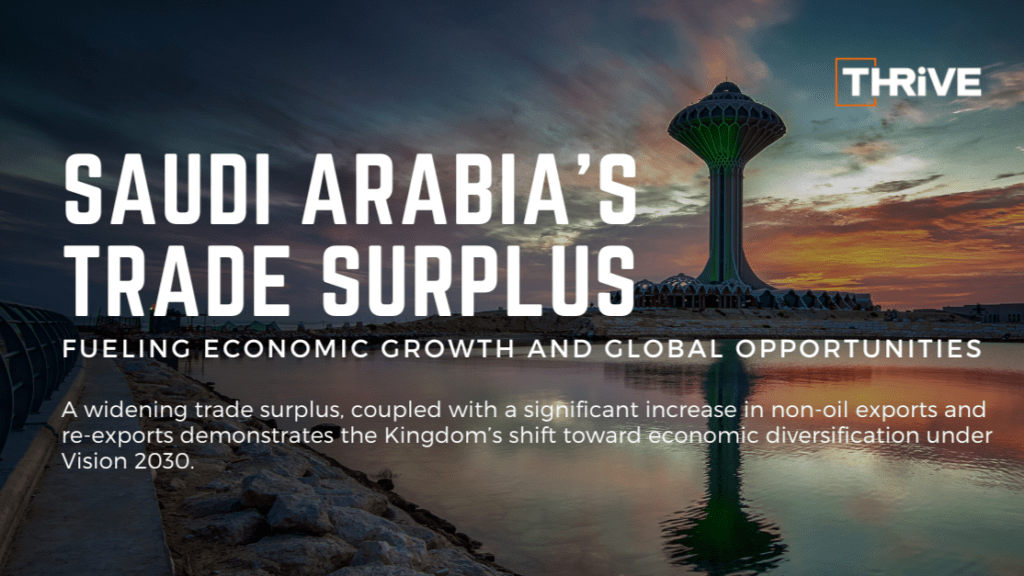Fueling Economic Growth and Global Opportunities: Saudi Arabia’s expanding trade surplus serves as a key indicator of the Kingdom’s growing economic strength and diversification efforts under Vision 2030. The recent data showing an increase in trade surplus, rising to SAR 16.9 billion (approximately USD 4.5 billion), highlights the nation’s ability to balance its trade while fostering growth in non-oil sectors. This positive trend reflects not only increased global demand for Saudi exports but also demonstrates the country’s long-term strategy to move beyond its reliance on oil revenues. The implications of this surplus extend across multiple industries, bringing new opportunities for investment, infrastructure development, and an increasing demand for a skilled workforce to sustain this momentum.
One of the primary drivers behind the rising trade surplus is the robust performance of Saudi Arabia’s non-oil exports, which have grown steadily over recent months. The government’s push to strengthen industrial production, expand logistics capabilities, and develop high-value manufacturing sectors has resulted in significant gains. Sectors such as petrochemicals, mining, and renewable energy have seen heightened demand in international markets, allowing Saudi businesses to leverage their competitive advantage in global trade. Additionally, a substantial 82.9% rise in re-exports suggests that Saudi Arabia is becoming a critical hub for trade and redistribution, solidifying its position as a logistics powerhouse in the region.
The role of strategic partnerships and free trade agreements has also played a crucial role in this economic transformation. Saudi Arabia’s deepening trade ties with Gulf Cooperation Council (GCC) nations, China, India, and Europe have resulted in a more diverse range of exports, ensuring that the country remains resilient against fluctuations in global oil prices. With new trade agreements and economic zones under development, businesses in Saudi Arabia now have access to a broader international consumer base, increasing the Kingdom’s overall economic output and enhancing its ability to attract foreign direct investment. The rise in non-oil exports by 19.7% in November 2024 further underscores the success of this approach, highlighting that the shift towards a diversified economy is gaining traction.
The impact of a growing trade surplus is far-reaching and extends beyond macroeconomic indicators. One of the most immediate benefits is the increased liquidity within the economy, which allows for greater investment in infrastructure, technology, and new business ventures. The surge in re-exports and non-oil trade means that more logistics hubs, warehousing facilities, and advanced transport networks will be required to meet rising demand. This directly translates into large-scale development projects, further driving the need for skilled professionals across multiple disciplines, including engineering, project management, supply chain logistics, and financial services.
As Saudi Arabia positions itself as a global trade leader, the demand for a skilled expatriate workforce will also continue to rise. The expansion of ports, free zones, and manufacturing clusters will require expertise from professionals in high-growth industries, ensuring that the country’s evolving economic landscape is supported by a workforce capable of sustaining long-term growth. The Saudi Logistics Hub initiative, aimed at transforming the Kingdom into a leading logistics gateway, is a clear example of how trade surplus-led investments are paving the way for employment opportunities across sectors such as transportation, automation, digital logistics, and customs operations.
Foreign investment is another critical aspect influenced by the widening trade surplus. With increased economic stability and a thriving non-oil export market, Saudi Arabia is becoming a highly attractive destination for international businesses seeking expansion in the Middle East. Investors are now more willing to commit capital to Saudi-based projects, knowing that the country has a strong financial foundation backed by trade performance. This is particularly visible in the rising number of foreign-owned businesses in Saudi Arabia, spanning from industrial production to technology-driven services, all of which benefit from the country’s stable and surplus-driven economy.
The continued strength of Saudi Arabia’s trade surplus reflects a broader economic shift that is creating new pathways for business expansion, infrastructure growth, and employment generation. While oil revenues still play a significant role, the steady rise of non-oil exports and re-exports showcases the success of policies aimed at fostering economic resilience and global integration. Looking ahead, the Kingdom is poised to leverage its financial and trade advantages to cement its status as a regional and global trade hub, attracting investment, boosting industrial development, and driving the demand for skilled professionals from around the world.
The expanding trade surplus is not just a positive financial indicator, it is a foundation for the future of Saudi Arabia’s economy, unlocking opportunities that will shape the Kingdom’s growth for decades to come.



















